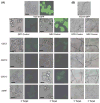Blastomyces dermatitidis septins CDC3, CDC10, and CDC12 impact the morphology of yeast and hyphae, but are not required for the phase transition
- PMID: 22783804
- PMCID: PMC3607453
- DOI: 10.3109/13693786.2012.699685
Blastomyces dermatitidis septins CDC3, CDC10, and CDC12 impact the morphology of yeast and hyphae, but are not required for the phase transition
Abstract
Blastomyces dermatitidis, the etiologic agent of blastomycosis, belongs to a group of thermally dimorphic fungi that change between mold (22°C) and yeast (37°C) in response to temperature. The contribution of structural proteins such as septins to this phase transition in these fungi remains poorly understood. Septins are GTPases that serve as a scaffold for proteins involved with cytokinesis, cell polarity, and cell morphology. In this study, we use a GFP sentinel RNA interference system to investigate the impact of CDC3, CDC10, CDC12, and ASPE on the morphology and phase transition of B. dermatitidis. Targeting CDC3, CDC10, and CDC12 by RNA interference resulted in yeast with aberrant morphology at 37°C with defects in cytokinesis. Downshifting the temperature to 22°C promoted the conversion to the mold phase, but did not abrogate the morphologic defects. CDC3, CDC10, and CDC12 knockdown strains grew as mold with curved, thickened hyphae. Knocking down ASPE transcript did not alter morphology of yeast at 37°C or mold at 22°C. Following an increase in temperature from 22°C to 37°C, all septin knockdown strains were able to revert to yeast. In conclusion, CDC3, CDC10, and CDC12 septin- encoding genes are required for proper morphology of yeast and hyphae, but are dispensable for the phase transition.
Conflict of interest statement
Figures





Similar articles
-
Quantitative analysis of septin Cdc10 & Cdc3-associated proteome during stress response in the fungal pathogen Cryptococcus neoformans.PLoS One. 2024 Dec 17;19(12):e0313444. doi: 10.1371/journal.pone.0313444. eCollection 2024. PLoS One. 2024. PMID: 39689097 Free PMC article.
-
Guanidine hydrochloride reactivates an ancient septin hetero-oligomer assembly pathway in budding yeast.Elife. 2020 Jan 28;9:e54355. doi: 10.7554/eLife.54355. Elife. 2020. PMID: 31990274 Free PMC article.
-
The step-wise pathway of septin hetero-octamer assembly in budding yeast.Elife. 2017 May 25;6:e23689. doi: 10.7554/eLife.23689. Elife. 2017. PMID: 28541184 Free PMC article.
-
Turning on virulence: Mechanisms that underpin the morphologic transition and pathogenicity of Blastomyces.Virulence. 2019 Dec;10(1):801-809. doi: 10.1080/21505594.2018.1449506. Epub 2018 Aug 1. Virulence. 2019. PMID: 29532714 Free PMC article. Review.
-
Molecular genetic analysis of Blastomyces dermatitidis reveals new insights about pathogenic mechanisms.Int J Med Microbiol. 2002 Oct;292(5-6):363-71. doi: 10.1078/1438-4221-00219. Int J Med Microbiol. 2002. PMID: 12452282 Review.
Cited by
-
Fungal pathogens are platforms for discovering novel and conserved septin properties.Curr Opin Microbiol. 2014 Aug;20:42-8. doi: 10.1016/j.mib.2014.04.004. Epub 2014 May 28. Curr Opin Microbiol. 2014. PMID: 24879478 Free PMC article. Review.
-
Fungal Morphology, Iron Homeostasis, and Lipid Metabolism Regulated by a GATA Transcription Factor in Blastomyces dermatitidis.PLoS Pathog. 2015 Jun 26;11(6):e1004959. doi: 10.1371/journal.ppat.1004959. eCollection 2015 Jun. PLoS Pathog. 2015. PMID: 26114571 Free PMC article.
References
-
- Wheat LJ, Slama TG, Eitzen HE, et al. A large urban outbreak of histoplasmosis: clinical features. Ann Intern Med. 1981;94:331–337. - PubMed
-
- Schneider E, Hajjeh RA, Spiegel RA, et al. A coccidioidomycosis outbreak following the Northridge, Calif, earthquake. JAMA. 1997;277:904–908. - PubMed
-
- Gauthier GM, Safdar N, Klein BS, Andes DR. Blastomycosis in solid organ transplant recipients. Transpl Infect Dis. 2007;9:310–317. - PubMed
Publication types
MeSH terms
Substances
Grants and funding
LinkOut - more resources
Full Text Sources
Other Literature Sources

